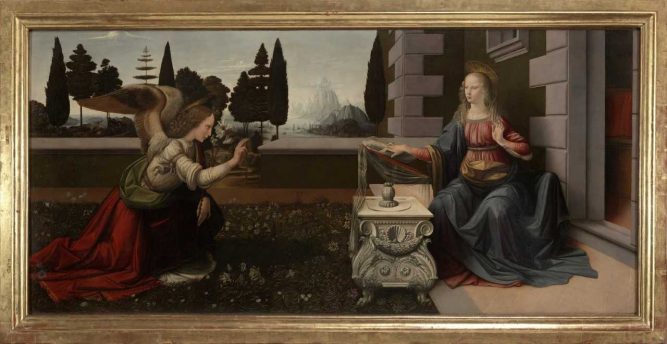New Leonardo Room Opens at the Uffizi

The Uffizi has just opened another room in a brand-new chronological layout along the second-floor corridor: a space dedicated entirely to the early works of Leonardo da Vinci. This room, spotlighting three pieces the artist painted before he left for Milan in 1482, is the pinnacle of the Uffizi’s 2018 reorganization efforts. In the works Baptism of Christ, Annunciation, and Adoration of the Magi, da Vinci’s artistic experiments and endeavors are clearly illustrated. Each painting testifies to his progress as a young apprentice to Verrocchio, growing with the Italian Renaissance and beginning to shape it.
In February of this year, a room dedicated to Caravaggio and the 17th Century was unveiled; a Michelangelo and Raphael room opened in June, focuses on the contact between them after da Vinci’s return to Florence in 1503. The Michelangelo and Raphael space is brimming with works compared to the new Room 35 of the Uffizi West Wing–a minimalist shrine to Leonardo’s 15th century achievements. Each of the three paintings stand alone on a wall, every detail begging for examination and admiration.
Visible on the left is the Baptism of Christ. The piece was commissioned by the monks of the San Salvi Church as an altarpiece, painted from 1475-8. The diversity of style within the painting is a perfect example of how tasks were divided in workshops of the time. The portions that Leonardo was assigned surpass those of his master both stylistically and technically. Verrocchio stuck to the traditional tempera-on-wood medium of the time—while beautiful nonetheless, it seems to lack the detail and depth of the techniques the young Leonardo pioneered.
Da Vinci’s refined use of sfumato is instantly recognizable, produced with his unique employment of oil paints, a new innovation of the time. The foggy, realistic beauty the method produces is especially noticeable in the left background landscape. The small, graceful figure of the angel in profile is another famous and striking part of the painting. Completed exclusively by Leonardo’s hand, the angel clutches Christ’s tunic with eyes fixed on the baptism scene in the foreground. According to Giorgio Vasari, the elegant brushstrokes of Leonardo’s tiny angel stunned Verrocchio instantly, convincing him of Leonardo’s insurmountable superiority and discouraging him from ever painting again.
The Annunciation is centered on the opposing wall. Long and rectangular in form, this painting for the church of Monte Oliveto exhibits another aspect of Leonardo’s development as an artist: his meticulous studies of nature and the physical world that permeated his work. The angel’s wings, folded as he kneels in front of Mary presenting a lily, are dark-plumed and birdlike, undeniably a product of his study of bird flight. The lofty Virgin sits at her lectern, right index finger tracing a word in her reading, holding her spot as she looks down, her line of sight angled down and out to the linear figure of Gabriel.
The shadow of the Annunciation angel, cast on the dark grass with precision, is another example, as is the apparent over-lengthiness of Mary’s right arm—hypothesized to account for the perspective of the viewer in the original church where it was hung, based on Leonardo’s studies of optics. These details enhance the already graceful, elongated frame, adding technical eloquence to a work that seems, by all accounts, a meditation on visual conceptions of distance.
The Adoration of the Magi, displayed on the room’s central wall. The piece was left unfinished when Leonardo left Florence for Milan. As a result, some sections are barely-sketched in remnants and others are more fleshed-out—arguably making it one of the most perfect depictions of the painter’s artistic process in existence.
The Holy Family is centered, with the Madonna becoming the nucleus of a busy, semi-circular procession that trails from foreground to background. It is a sprawling depiction of countless figures and micro-scenes, all contained within a single, enthralling frame. The recent, painstaking restoration (funded by the Amici degli Uffizi) required innovative techniques and approaches to the centuries-old, uncompleted work, taking over five years.
The grey coloration of the section was chosen to mimic church interiors of the period, a nod to where the biblical tableaux were originally explained. The ancient “spatula technique” was used to apply the paint, evoking the dim pallor of renaissance nave. Natural white-hued light from a tempered skylight washes the room in a neutral tone perfect for observation.
As in the two other new rooms on the third floor west-wing, the display cases for each of the paintings are micro-climatically controlled. The glass cases minimize refracted light, making it seem as if there is nothing but air between the viewer and the painting (while simultaneously minimizing the negative effects of a consistent human presence in the room).
Director of the Gallerie degli Uffizi, Eike Schmidt, stresses how both the restoration and layout are designed to encourage “a slow, meditative visit in which the visitor can interact with the works and grasp Leonardo’s early stylistic development.” Its place in the gallery—directly following the rooms of the Quattrocento—is undeniably instrumental in the Uffizi’s goal of enriching art with history, and vice versa. (tyler bunton)
